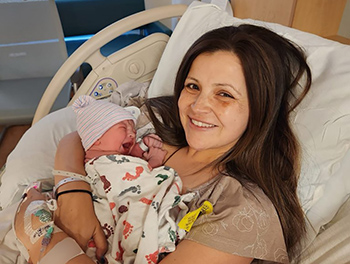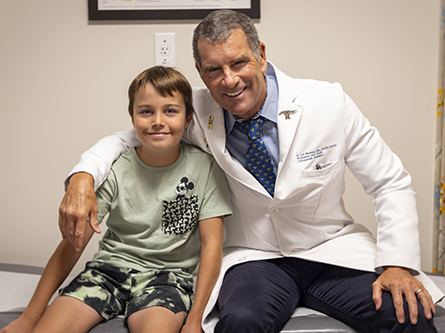Preeclampsia is a serious condition typically associated with pregnancy. It is characterized by high blood pressure, elevated levels of protein in urine (proteinuria) and headache, among other symptoms. Preeclampsia usually begins after 20 weeks of pregnancy. Left untreated, preeclampsia can lead to serious — even fatal — complications for both the mother and baby. It typically resolves with the birth of the baby.

But Kristin Apicella had not experienced any of those symptoms during her pregnancy. Only afterward did she develop a low-grade headache. She tried to talk herself out of it.
“I knew it could still happen, but it’s very rare, especially with no other issues prior to delivery,” Apicella said. “As a new mom, I was so caught up with my baby. You’re often not looking out for things for yourself.”
Apicella reached for her blood pressure cuff and took a reading. Her blood pressure, which was usually low, was mildly elevated.
“It wasn’t crazy initially, but I kept monitoring my blood pressure through the day and it just kept creeping up,” Apicella said. “I still had a headache and some swelling in my feet, and when I took my blood pressure later that evening, it was in the severe range, so I decided to go to the ER near my home.”
“I was very tearful as I sat down with the triage nurse in the emergency room and shared what had been going on,” Apicella said.
Apicella was told that her headache was likely due to lack of sleep. The triage nurse attributed her high blood pressure to stress and her swelling to fluids during labor.
“As he’s telling me this, the blood pressure cuff is just squeezing and squeezing," Apicella said. “It can’t get a reading because it’s so high.”
When the blood pressure machine finally completed its reading, it displayed 182/110, which is dangerously high.
“He got a really shocked look on his face and then everything went really fast from there,” Apicella said. “I am shaking just thinking back to it.”
Apicella was soon diagnosed with a rare condition nearly identical to preeclampsia, only that it occurs after giving birth. Postpartum preeclampsia usually develops within 48 hours after birth but can appear up to 6 weeks or later postpartum.





